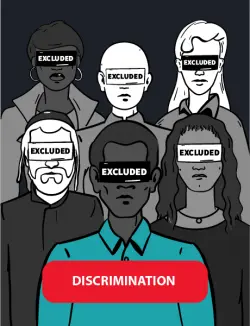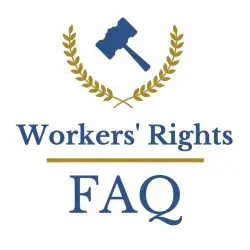What is Discrimination?
Your questions about workers’ rights, answered

Discrimination affects millions of Americans every year. The law protects people from discrimination in housing, in the workplace, and in other settings.
Employment discrimination can stop you from getting a job, cause unfair treatment in the workplace, or even end in wrongful termination.
Our FAQ explains what is discrimination, protected classes, and types of employment discrimination.
Contact an employment lawyer to find out if you have a workplace discrimination case.
What is discrimination?
In the workplace, discrimination means treating a job applicant or employee unfavorably because they belong to a protected class.
This includes discrimination because of someone’s race, gender, sex, age, religion, disability, sexual orientation, transgender status, and more. Discriminating against someone at work because of their protected characteristics violates the law.
Discrimination also includes creating a hostile work environment because of harassment based on race, gender, age, religion, or another protected characteristic. Targeting people in the workplace because of their identity violates federal, state, and New York City laws.
What are protected classes?
Discrimination laws recognize protected classes of people, who are protected against employment discrimination.
Federal discrimination laws protect the following groups:
- People with a common race, religion, color, or national origin
- People over 40
- People with a physical or mental disability, including a perceived disability
- Men and women on the basis of sex
All U.S. citizens fall into one of these protected classes.
New York City law includes additional protected classes. It also covers age discrimination against all ages, discrimination on the basis of family status, marital status, or caregiver status, and discrimination based on arrest record or credit score. In New York City, it is also illegal to discriminate against job applicants by requesting salary history.
What are some examples of discrimination?
Employment discrimination can take several forms. A hiring manager may discriminate against a job candidate because of her gender, age, or race.
Employees may also face discrimination when it comes to promotions, raises, job assignments, or other factors that influence their success at work. If, for example, a company decides that female employees cannot work the higher-paid night shift, claiming it is too dangerous for women, that may constitute discrimination.
Discrimination can also occur due to a hostile work environment. If a coworker loudly attacks members of a certain religious group, creating an uncomfortable workplace, this may qualify as discrimination.
Similarly, if a vendor uses racial slurs or offensively attacks one particular race, this can create a hostile work environment.
The victims of a hostile work environment do not have to be members of the protected class targeted. If offensive behavior at work affects your ability to do your job, you may have a claim.
What are the different forms of discrimination?
Discrimination can take many forms. In New York City, discrimination against people because of their race, sex, gender, religion, or disability all violates the law.
Discrimination can include unfavorable treatment during the hiring process or while employed with a company, and a hostile work environment because of offensive behaviors, actions, and words that target a protected class.
Learn more about common forms of workplace discrimination:
- Race Discrimination
- Gender Discrimination
- Religious Discrimination
- Age Discrimination
- Disability Discrimination
- Pregnancy Discrimination
- National Origin Discrimination
- Equal Pay
Is favoritism considered discrimination?
What is discrimination — does it include favoritism?
In many cases, favoritism may not qualify as discrimination. However, if favoritism in the workplace is based on protected characteristics, it may cross the line into discrimination.
For example, a boss who only promoted men may be guilty of discrimination. Similarly, if a company without a religious mission only hired members of the owner’s religious background, it may be discrimination.
What is an example of direct discrimination?
Direct discrimination occurs when an employer treats a job applicant or employee unfavorably because of their membership in a protected class.
For example, if a hiring manager refused to hire a qualified candidate because he was black, that would qualify as direct discrimination. Similarly, if a company withheld promotions from women, that would be direct discrimination.
What is an example of indirect discrimination?
Indirect discrimination occurs when a policy applied to everyone has a harmful effect on certain protected groups. This may also be called unintentional discrimination or discriminatory policies.
These policies may appear neutral, but they may qualify as discrimination if they disproportionately harm certain people.
For example, an apparently neutral policy that fire department applicants must be at least 5’8” disproportionately excludes women. This policy may be discriminatory unless the fire department can demonstrate that the requirement is related to job performance.
What is the main cause of discrimination?
Discrimination in the workplace may be based on stereotypes, prejudices, or bigotry.
A company may refuse to promote women, for example, because the executives do not believe women are well suited for management positions. Similarly, a daycare owner may refuse to hire men as daycare providers because of a prejudice against men in caregiver roles.
Workplace discrimination may also occur without intending to treat a group unfavorably. A seemingly neutral policy might disproportionately harm members of one race or religious group, for example. Or a manager may promote employees based on their fit with the company culture, without realizing that the standard hurts certain groups.
Regardless of the cause of workplace discrimination, employees have the right to a discrimination-free environment. Victims of workplace discrimination can file a claim to recover lost wages and to receive compensatory and punitive damages.
What to do about discrimination?
If you have been the victim of workplace discrimination, you have legal rights.
Federal, state, and New York City laws protect employees from discrimination at work, including discrimination on the basis of race, gender, national origin, sexual orientation, transgender status, caregiver status, and marital status. You can contact a workplace discrimination lawyer to learn more about filing a claim.
If you’re in the New York City area, contact discrimination lawyer Charles Joseph for a free consultation. You may have a discrimination claim against your employer.
Read more about workplace discrimination, how to file a claim, and potential damages.
Related FAQs
